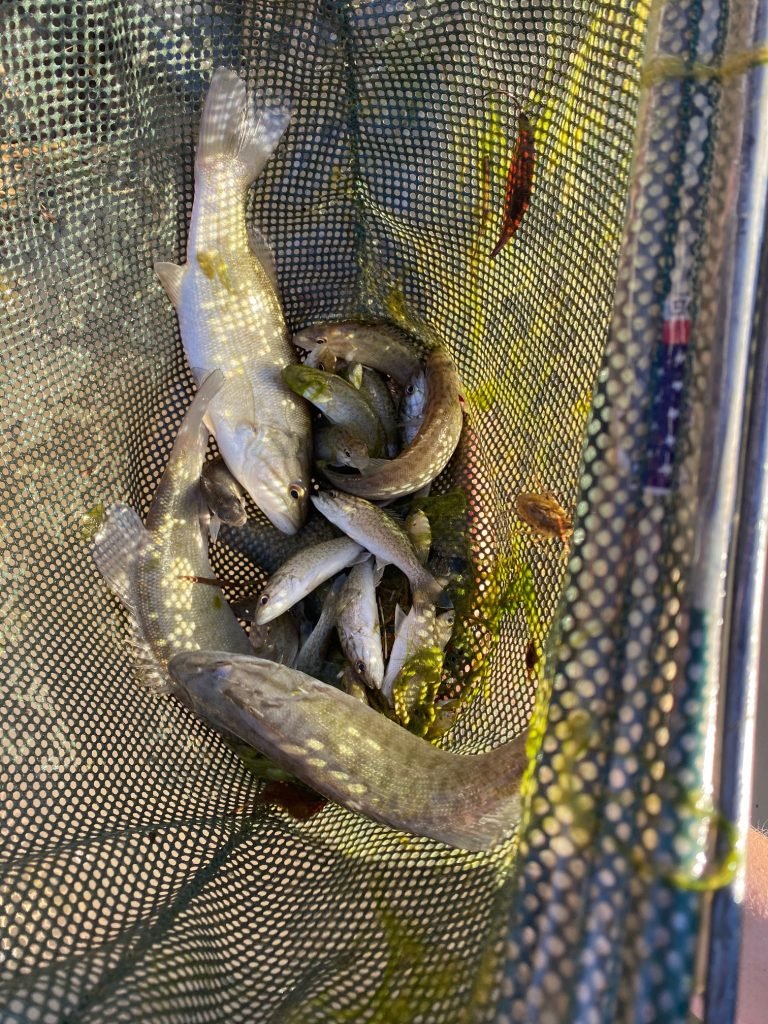Smallmouth Genetics
We're big into genetics. Some biologists will tell you that water quality, food web, etc. are more important than genetics; in our experience, nothing trumps genetics. Here's an easy way to think about how important genetics are: a poorly-fed Great Dane is still going to end up several times bigger than a well-fed Dachsund. Likewise, a poorly-fed blue catfish will end up larger than a well-fed gambusia. They have different genetic codes, and those codes determine how big they can get.There is of course less difference in the genetic potential of a Florida largemouth and a northern largemouth, for example, but the difference is still pronounced, just as the difference between a coppernose or hand-painted bluegill and a northern bluegill is pronounced. When we first decided to start a fish farm, we knew smallmouth were one of the species we wanted to raise; and because we believe nothing is more crucial to the success of your pond than having the best genetics possible, we wanted to have smallmouth with superior genetics. The world record smallmouth was caught from Dale Hollow Lake, which straddles the Tennessee-Kentucky border, in 1955, and weighed eleven pounds fifteen ounces. Dale Hollow is still known for producing outsized smallmouth, so we traveled there back in March of this year - just as COVID was becoming a pandemic - to try to catch our broodstock.Dale Hollow has a unique slot limit: only two fish per day per angler can be kept; one has to be under 16", and one has to be over 21". As you might imagine, those 21"+ fish are not easy to come by; however, after four hard days of fishing, we ended up with seven fish under 16" and one that measured 21.5". I lost one the first day of fishing that probably would have gone eight pounds or more - easily far and away the biggest smallmouth I have ever seen. So we started out with just eight brood stock in a one-acre pond. They had plenty to eat, fathead minnows we had stocked into the pond shortly before the smallmouth; we added gravel in a few places to further encourage spawning. But we figured it was a long shot at best that they would spawn, as prime time for smallmouth breeding had already come and gone by the time we put them in the pond, it was a completely different environment than what they had just been taken from, it would likely take them some time to acclimate, etc. We didn't know they had spawned until sometime in October when I saw a dead one about three inches long floating near the water's edge. I didn't want to seine them while it was hot, so we waited for cooler weather. Keep in mind that none of these fish existed in March of this year - they all hatched out since that time, and have grown to the sizes you see in the photos below from sometime in April until now.According to the U.S. Fish and Wildlife Service, it normally takes three to five years for a smallmouth to reach twelve inches in length:https://www.fws.gov/fisheries/freshwater-fish-of-america/smallmouth_bass.htmlThis study mentions 100cm, or just under four inches, as the upper end of size attained by smallmouth in their first growing season, noting that in one exceptional lake in Washington state, the smallmouth averaged this length after one season:http://citeseerx.ist.psu.edu/viewdoc/download?doi=10.1.1.577.2989&rep=rep1&type=pdfOne growing season would be from when the fish hatched out in the spring, until the onset of winter. In Washington, for example, smallmouth would spawn in April or May, and winter would begin in November or December. Here in Tennessee, they will usually spawn in March, and winter begins in December.We seined our smallmouth pond on November 16. The smallest of the eight broodstock we stocked into this pond on March 26 was 13" long, and all of said broodstock were larger on November 16 than they had been in March. Here are some of the young-of-year that hatched out in that pond since April: Note that there are three fish just in this netful that are ten inches or better. We had several more this size, and several more than were six inches or better. The "underperformers" among these fish still averaged 4-5" long.Just imagine what the biggest three fish in that photo will look like five years from now.
Note that there are three fish just in this netful that are ten inches or better. We had several more this size, and several more than were six inches or better. The "underperformers" among these fish still averaged 4-5" long.Just imagine what the biggest three fish in that photo will look like five years from now.
